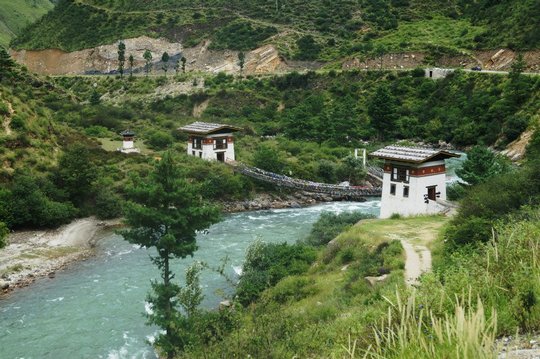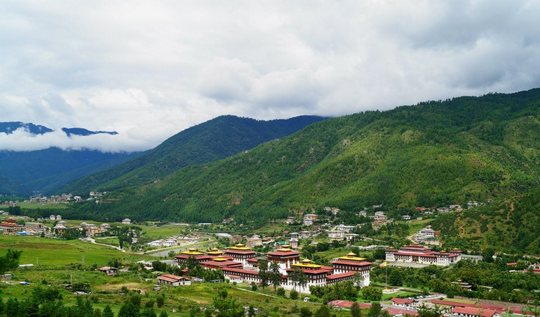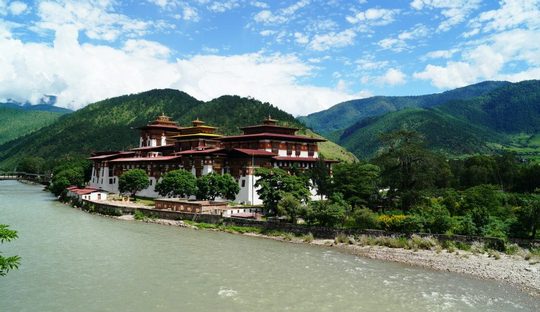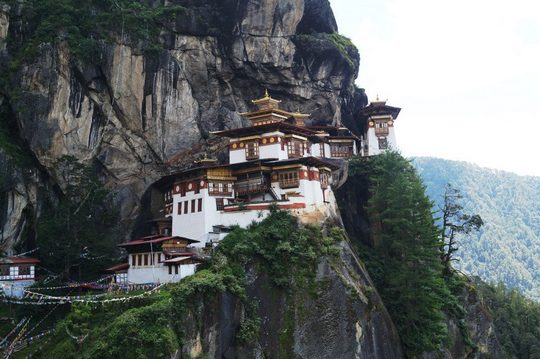Photographs: Rohan Tiwary/for Rediff.com Harnoor Channi-Tiwary
Harnoor Channi-Tiwary visited Bhutan and returned with a bagful of memories. Read on!
Bhutan, a nation safely tucked away in the folds of mammoths like India and China. Yet, a nation that still manages to keep a unique identity. Bhutan is a contradiction. Old world charm that goes hand in hand with progressive thinking (did you know that education in English medium and medical for all including tourists is completely free here?).
There is certain mysticism that envelopes this land and it is this sense of discovering the unblemished that attracted me as I planned a trip there.
While travelling here, you won't miss home. The supermarkets sell Kurkure, the currency equals ours (such a relief to travel abroad and buy water for 10 bucks!) and almost everyone speaks both English and Hindi. But don't be fooled by appearances.
Travelling to Bhutan is not as cheap as one may assume and certainly not like Nepal, infact it can be more expensive than Europe. Tourism is controlled in a manner to ease planning woes of tourists.
If you like to personally book and plan your travels, this is not a place for you. Tripadvisor won't help much and there is almost no information online that can aid you. But if you plan way ahead of time all you must do is to reach out to an authorised travel agent in Bhutan. For a pre-fixed rate per day, they will take care of your hotel, car driver, guide, food and permits.
To maintain Bhutan as an exclusive destination, the government requires non Indian tourists to pay $250 per day which covers the above as well as a very high tourist tax. This makes it VERY expensive for foreigners to travel here.
Druk Air the only international airline that flies here was the perfect setting for us to start our vacation. The food was hot and delicious, the hostesses courteous and the view of the Himalayas stunning.
Paro airport is one of the most difficult ones to land in, it being in a valley. It is almost surreal, watching the huge plane skilfully glide between the mountains (the wings so close to them) as it lands.
STUNNING PHOTOS: The heavenly Kingdom of Bhutan
Image: ThimpuPhotographs: Rohan Tiwary/for Rediff.com
Thimpu
A 45-minute drive from airport put us right in the heart of the capital city. If your schedule permits, plan to spend a few days here to leisurely experience the town. It was my favourite town in the country, with amazing food, a variety of sights to see and just a lovely place to stroll around.
There are many stay options in Thimpu, with the highest end being the rooms at Taj Tashi which rent at $450.
We stayed at the Druk Hotel, a landmark 5 star hotel in the middle of town and couldn't have made a better decision. The hotel was close to all the food places (with lipsmacking food inhouse, we often did not even have to venture out), had a supermarket downstairs and the rooms were just heavenly with flat screen TVs and claw feet bathtubs. Highly recommended.
The largest sitting statue of Lord Buddha is being constructed on a hilltop outside the town by two non-Bhutanese businessmen. It was still under construction when we went but the views from the platform were lovely.
A little drive from here took us to the Takin Zoo. The Takin is Bhutan's national animal. Something like a cow with a goat's head, it looks like it came straight out of a mythological story. We also visited the National Museum which is actually a traditional house showcasing typical Bhutanese life and culture. Very unique and interesting.
Every big town has a dzong, a fortress that houses the administration as well as spiritual centre. The one in Thimpu also happens to be where the king sits (his humble palace is next door). For that reason, it is open only from 5.30-6.30pm for visitors Monday-Friday and you may be restricted to the courtyard and temple area.
We missed the flag ceremony at 5pm and were thankful that our guide told us that we must be attired in full sleeves and full pants/skirts (true for all dzongs and monasteries) and that we couldn't use an umbrella out of respect to the king!
Thimpu is a foodie's paradise. Whether it was the Burgers and Pork Ribs at The Zone or the extravagant Bhutanese feast at Bhutan Kitchen, the food is just outstanding. An outdoor patio at the Seasons restaurant was the perfect setting for the creamy pastas and crispy pizzas they dished out. And for our coffee fix, Karmas Coffee (and sandwiches) was unbeatable.
Loving what we had already seen and in anticipation of more, we packed our bags and left for Punakha.
STUNNING PHOTOS: The heavenly Kingdom of Bhutan
Image: PunakhaPhotographs: Rohan Tiwary/for Rediff.com
Punakha
Punakha was the old capital of the country before Thimpu. A three-hour drive away from the capital, it houses the most stunning Dzong of the region. Punakha is a must stop for 1 night if you cannot make the trip further east towards Bumthang.
Enroute, we crossed Dochula Pass at the height of 11,000ft and before we knew it, we were in Punakha. Unlike Thimpu and Paro, this is a more spread out district and doesn't have a touristy city centre.
The highlight of Punakha has to be the gorgeous Dzong. Built on the confluence of 2 rivers, one male and one female, this dzong is the most imposing and perhaps the most ornate as well. Besides the dzong, we also trekked to the Temple of Fertility (it is a 20-minute trek through paddy fields).
It is believed in Bhutan that this is a very holy site for expectant parents who come here to pray and then return later with their babies once their wishes have been fulfilled. The houses around here have phalluses painted on them!
Unlike in Thimpu, food options in Punakha are very limited. Besides Chhime Lhakhang Cafeteria at the base of the Temple of Fertility trek, it is advised you eat in your own hotel (which may not be too exciting either).
We made the (humungous) mistake of deciding to splurge on a meal at the very exclusive Aman Kora resort. Unfortunately, the $50 per head translated into a bowl of lettuce and tasteless hummus. Entirely avoidable.
We couldn't visit the Fort at Wangdue as it burnt down just a few months ago. It is a tragedy to see this 17th Century Dzong now reduced to ruins. Fires caused by butter lamps or short circuits are a very real threat to all of Bhutan's old monasteries and structures as they are mostly built with wood. Many structures including the well known Tiger's Nest have been partially burnt in the past and thereafter restored.
STUNNING PHOTOS: The heavenly Kingdom of Bhutan
Image: Tiger's NestPhotographs: Rohan Tiwary/for Rediff.com
Paro
As we traced our steps back towards our last destination -- Paro the drive was scenic and peaceful. There is something so pure in the air in Bhutan, and the land so scenic, one can just sit and stare for hours at any spot.
The Paro Dzong was unlike any other that we had seen till now. It reminded one more of being a fortress than a monastery. The colours were brighter and even the inner temple much smaller but somehow more peaceful.
The town centre in Paro is a lovely little lane lined with one storey high traditional buildings. We picked up a few souvenirs from here but the prices were incredibly high and negotiation almost impossible. The Bhutanese do not like to bargain and may reduce the rate by Rs 50 or Rs 100 but push more and they may take offence.
We stayed in an absolute little piece of heaven called Nak Sel Boutique Hotel and Spa. It sits on top of a hill above Paro and the rooms are large, tastefully done and have French windows with panoramic views of the mountains.
The spa is overpriced with a 1-hour massage for $80 but overall the property is probably one of the best in Paro and a perfect place to stay while in the town.
The food in Paro, like in Punakha is also limited to your hotel. The locals do not have a culture of eating out and thus options are very limited. The only exception being the Bhutan Tourism cafeteria halfway up the trek to Tiger's Nest which serves delicious lunch for a much needed stop on your climb.
This brings me to the climax of our Bhutan trip -- the Tiger's Nest. When the car pulled into the parking lot, I looked up as far as I could and I saw a speck of white on a cliff face, and almost turned the car back.
It seemed almost an impossible ask, to trek up a mountain, cross over on a bridge under a waterfall to the cliff where the monastery precariously balances itself, all this with a 18-month old baby strapped to our backs. But our enthusiasm not to miss out on this opportunity overrode our fear and we trudged on.
Young local boys literally skipped ahead of us while tourists huffed and puffed and looked at each other wondering what madness had taken them over. The climb took us 2.5 hours, not too bad a feat, we were told by our guide.
The last half an hour after last look out point was the most difficult. But all our exhaustion vanished as we turned a corner and saw the monastery up close for the first time.
It was gravity defying and beautiful. Standing on the bridge between the two mountains, drenched with the spray from the waterfall, I just paused a moment to appreciate nature, and thank god for the opportunity to help me reach here.
Our flight the next morning took off on time in spite of dense clouds affecting visibility and we bid adieu to this magical land, thankful that we managed to see it while it still remained untouched and pure.
Bhutan may not be on your list of must see places – but that would be a great mistake. If you were to take my advice, add it now! And start collecting money for the trip because this is one trip that can make a (big) dent in your wallet.
Best time to travel – March/April or October
Travel Agent we used and highly recommend – Gaki Travels (http://bhutangakitravels.com/)





Comment
article